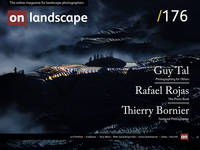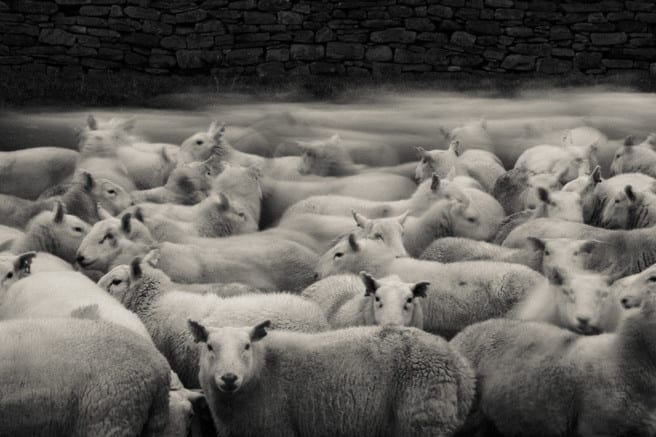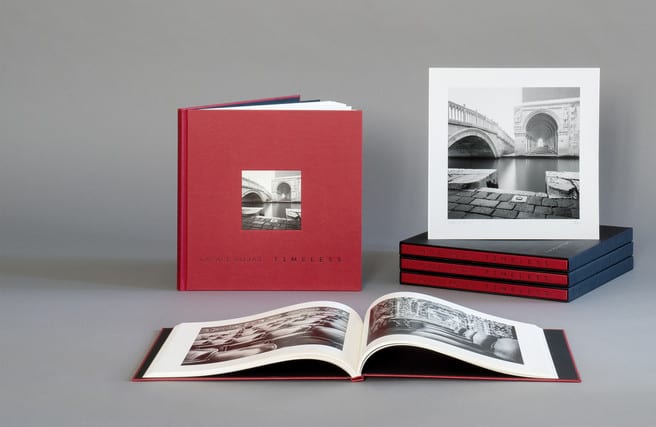A key medium to convey inspiration

Rafael Rojas
Rafael Rojas (Master Hasselblad 2014, MA Photography, ARPS), is a Swiss and Spanish full-time artist photographer, lecturer, author, and creativity mentor.
He has been involved in teaching most of his life, first helping young students, then teaching undergrads, and later as a university lecturer.
Nowadays, his teaching activities focus on helping photographers see the world with different eyes and use photography as a tool of personal and creative expression.
After seven years of work, the MasterCOURSE “Photography with Intent”, an intensive mentoring program for Expressive Photographers, has become the apex of his teaching career and his utmost contribution to the Community of Photographers.
Introduction
At the end of the year, and before embarking on the celebrations that typically surround these dates, another ceremony takes place: accounting. And every time we get to the end, I get astounded by the amount of money spent on books throughout the year. “That much? really? It cannot be!” are the words that leave my mouth every time. And still, I never regret a single penny being spent on books. And neither my wife, by the way.
It is curious, how big is the resistance to buy photography books among most photographers. It is true that photographic books, particularly beautiful art-books, have always been something niche and particularly expensive, big, heavy and difficult to fit in our meagre shelves. And yet, these disadvantages are quickly outnumbered by the immeasurable amount of pleasure and enlightenment they provide.
I still remember my own reluctance many years ago, when I started to call myself a photographer, to buy photography books. Like many others, I kindled my passion for photography mainly thanks to the digital revolution of the medium and was used to looking at the work of other photographers on the screen of a computer. I did not feel the need at the time to go with the expense of purchasing a book and finding it a place in the living room. After all, I already knew by heart the work of my favourite photographers from seeing them on screens, right? One day, after some initial hesitation, I decided to spend $150 for a book from one of my favourite old Masters, Brett Weston. When the wonderfully printed and edited book “Brett Weston: Master Photographer” arrived home and I opened it on my lap, I realised what I had been missing all those years. [paid]
There are different reasons why books provide enlightenment and meaning which is absent from other supports. The physicality, the permanence, the ritual embedded in the process of opening a book and absorbing its content, the slowness of the process, the introspective and fully sensorial experience provided, the context and the narrative, the textuality and the concept… are some of them.
The Permanence
There are different unique properties of books when it comes to displaying fine photography. One of them is the sense of permanence associated with them.
The old adage said that in order to obtain immortality, one should have offspring, plant a tree and write a book. Books have always been associated with a strong character of legacy and heritage, resisting time and letting us share with future generations knowledge, enlightenment and inspiration.
Is interesting to think that even today, on the crest of the digital revolution, having a photograph printed on a piece of paper gives a permanence than bits and pixels cannot guarantee. We do not know whether in the future the digital supports will be able to read our current files, let alone be sure those files will not be corrupted, deleted or lost due to data rot. What we know is that a printed photography book, if properly made and store, can last for many centuries.
Very often, this is less important in practical terms than it is in psychological terms. It might be or not important than our book lasts forever (what is forever, after all?). However, the idea a book might be around even after we are gone sets a very interesting state of mind. A book is something not supposed to be consumed instantly and thrown away but made to last. As a result, the typical mindset is not one of programmed obsolescence and compromise, of making something good enough to survive for a brief span of time. On the contrary, a firm strive for excellence typically defines the process and the purpose of making a book.
The physical existence
According to some research, most people think of electronic media as things they use, and of books as things they own. This sense of ownership is way more than just a lust for possessing, so much embedded in human nature. It is more connected to a certain feeling of pride, the pride of owning a beautiful object fruit of the work and passion of a number of people. When we talk about owning a book, we are talking about owning a piece of the soul of its creator(s), the embodiment of some of the noblest traits of human nature. A photography book and its physical existence provide way more than mere convenience, usefulness or practicality. They are not made nor acquired to provide solutions or carry mere information. They have an almost metaphorical value, where we associate the book to the artist, his work, his philosophy, his life.
It is also the physical existence of books which make them prone to be shared, given, passed on to other people and generations. They can be dedicated, signed, given away to a loved one. Due to their physical existence, books become the support for emotions like love, friendship and gratefulness. Who would sign an electronic file?
The multi-sensorial character of books
Printed material works by reflectance, as opposed to screens which work as the transmittance of light. This means the visual experience of contemplating a photography book will be very much influenced by the quality of the light falling on the pages. This is one of the beautiful aspects of printed books. During the evening, under the warm lights of our cosy living room, we will obtain a certain feeling that will be different from the one we experience when looking at the book under the light of noon. It is as if the mood of the photographs would suit that of the moment and environment chosen to experience the book.
The brain also reacts in different ways to visual stimuli printed on paper than it does to information transmitted through screens. Multiple research has proved that different parts of the brain are activated according to whether it is exposed to printed material or screens. You might have experienced this when correcting text on your computer. All seems right after hours of work, but the moment you print the page many mistakes jump at you as if they had been hiding in the document. Editing photographs is another good example. Even when the printed photograph looks essentially the same as the screen, we observe areas which are dissonant in tone or colour that did not bother us at all on the screen.
But the multiple nature of the visual experience provided by books is just the tip of the iceberg. Below the sea level, there is much more information and sensorial stimuli that, even if not often seen or consciously acknowledged, is felt and hugely adds to the experience we have.
The very first moment we touch the paper, a lot of information is coming through our fingers directly to our brain. The "tooth" of the paper, that is, its structure and tactile qualities can transmit a lot. A soft and silky paper will make us feel calm and relaxed and will give a delicate and inviting character to the photographs. A textured, grainy and thick paper will give strength, power and materiality to the subject. The volume of the paper will also confer an emotional connotation. Flimsy paper will transmit airiness and surrealism, a solid and thick paper will transmit luxury, stability, permanence and solemnity. When the page is turned, the rustle of the paper adds a bit more of information. The smell of paper and ink also kicks in. All these stimuli come through without us being consciously aware, in the same way, we are affected by the body language of a person we are talking to. However, they profoundly affect the way we understand and feel a photographic book and can hugely complement and resonate with the overall message and the artist's original vision.
The ritual character
There is something ritual about enjoying a beautiful photography book. First of all, there is the deliberate nature of the act. One decides to put aside some time, sit down comfortably, eventually put some music, pour some tea on a cup and open a book in order to contemplate slowly, in small sips, its content. When enjoying a book, there is no rush, there is no goal rather than just pure enjoyment. The process is long lasting. The next time we decide to enjoy a few more photographs, we might have changed, our mood might have changed. The work printed in a book is not static, and by exposing ourselves to it during a long period of time, we see how it evolves as we also evolve. Good photographs can hang from our walls for many years, without us becoming never bored of them. That is the long-lasting power of good photography. Books provide the same, with the extra bonus of incorporating several dozens of photographs. We do not "read" photography books, or just "get them" after a first browse. Would you drink a whole bottle of the finest whiskey at one go? The same thing happens with books.
This slow, deliberate and purposeful behaviour so inherent in the act of enjoying a book seems to contrast wildly when talking about digital support or social media. When confronted with screens and devices, our threshold of patience plummets dramatically, and we seldom allot more than a few milliseconds to any photograph. As a result, the best photographs, those who unveil their mystery, charm and magic not suddenly but with subtlety, those who grow up with time, get lost. This photography, the one that lures us, captivates us for many years to come, makes us wonder and think, feel and see the world in a different way, finds its best medium in the art book.
Long-lasting memories
Psychologists talk about the meta-cognitive learning schemes inherent to printed material or electronic media. Research has shown that we learn more, remember more and digest more when confronted with printed material than digitally supported media. This is especially the case with photography. Due to its marked visual nature, the brain gets in a different zone when we open a book. Images are engraved more deeply in our mind and we tend to remember them better in time. This is particularly important for photographers and other visual artists. The creation of an unconscious "bank of images" in the back of our mind is what gives us visual ingredients to play with and come up with personal and creative renditions of the world. No artist creates in a void, and every time we photograph, we are putting together wires of feelings, souvenirs, concepts and images we have seen during our life which have marked us whatsoever. Being confronted with printed material gives us a lead when it comes to visual literacy.
More than a bunch of images
Until now, all the advantages listed could apply to all printed photographic material. A single fine print or a small portfolio share with the book the qualities of permanence, physical existence, multi-sensorial nature and provide a ritual of slow enjoyment to the observer. However, the book provides something else that none of the other printed photographic material provides: narrative, context and comprehensive vision.
The individual image is frequently a strong, powerful and expressive image that can stand alone and still convey the message to the observer. But individual pictures, or “best hits” like Brooks Jensen calls them, frequently offer a mere glimpse of the expressive power of the photographer. With only one image, everything must be said within that individual frame.
In contrast to the unique isolated photograph, books focus on photographic projects. A photographic body of work is much more than a collection of images. A good project tells a story, transmits a deliberate idea or message and shows a coherent way of seeing the world.
A good book will have to provide a narrative and deliver the message as a story, with its beginning, development, and end. Being a good photographer does not suffice to make a good photobook. Being a good editor and a good storyteller is also part of the “cahier de charges”.
The beauty of a good photo book, as opposed to the single image approach, is that we can find inside strong resonances taking place between different images, that as a result see their expressive force increased. Encapsulated within a full body of work properly arranged and edited, we can discover and understand complex messages in a more effective way. Rather than relying on one single image, we are granted a whole succession of visual sentences to tell us the whole story.
The book is the ultimate trial for any photographer. Working on a book is way more demanding than creating a strong image out of a lucky strike. Not only it demands more work, time and energy. It also requires a clear intent and idea from the photographer, and enough technical, compositional, editorial and logistical skills to make it happen.
The results, however, frequently reward the effort. By working on a book for a certain amount of time, any photographer will develop a better understanding of his subject and experience an increasing wonder and love for it. That will forcibly lead him to a stronger connection with the subject and to a more profound message that demands to be shared with the audience.
The context
Another decisive element that makes photo books a key medium to convey inspiration, knowledge and provoke reflection in the observer, is their contextual value. Most photo books come accompanied by an artist statement or a foreword written by a third person, like a critic or a curator.
Whatever the style or artistic movement represented in the work is, the textuality and critical analysis provided within most books frequently bring with it the possibility of going beyond the mere visual experience and tapping into the intent of the photographer and the metaphorical value of his work in a more effective way.
Conclusion
Many are the photographers who ask me how to improve, make their work deeper and more meaningful, acquire higher levels of maturity and sophistication in their photography and get closer to their personal vision. The answer, typically long, frequently includes, among other things, the study of our own work and that of other practitioners, reflection and introspection. Books, due to their inherent characteristics, provide the ideal medium to absorb, digest and analyse the work made by other photographers. When exposed to good photo books, we can find full bodies of work organised with coherence around a solid intent and message that orchestrates the whole project.
This intent and this message are conveyed through a careful sequencing of images, properly edited and appropriately put in value. Photobooks work through a multitude of different channels of communication and go well beyond the superficial visual experience typically provided by a quick glance to an image on a computer screen.
We photographers do not hesitate to spend thousands of pounds on the last lens or the new mirrorless camera, and still, frown upon the idea of spending £90 on a good photographic book. Trading one of those lenses for a shelf full of photobooks might make a bigger difference than you think. The only problem is, sooner than later you will need more shelves around!
[/s2If]









